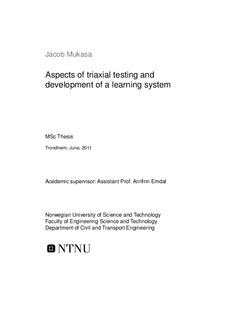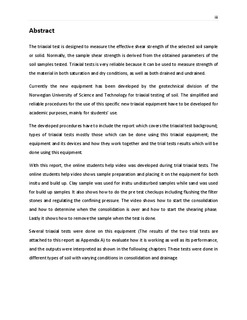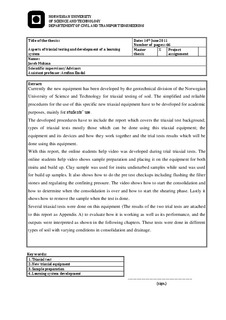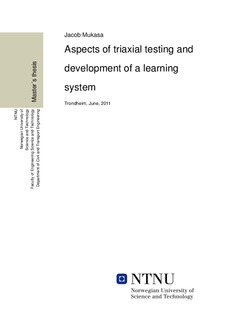| dc.contributor.author | Mukasa, Jacob | nb_NO |
| dc.date.accessioned | 2014-12-19T11:27:45Z | |
| dc.date.available | 2014-12-19T11:27:45Z | |
| dc.date.created | 2011-11-09 | nb_NO |
| dc.date.issued | 2011 | nb_NO |
| dc.identifier | 455191 | nb_NO |
| dc.identifier.uri | http://hdl.handle.net/11250/231851 | |
| dc.description.abstract | The triaxial test is designed to measure the effective shear strength of the selected soil sample or solid. Normally, the sample shear strength is derived from the obtained parameters of the soil samples tested. Triaxial tests is very reliable because it can be used to measure strength of the material in both saturation and dry conditions, as well as both drained and undrained.
Currently the new equipment has been developed by the geotechnical division of the Norwegian University of Science and Technology for triaxial testing of soil. The simplified and reliable procedures for the use of this specific new triaxial equipment have to be developed for academic purposes, mainly for students’ use.
The developed procedures have to include the report which covers the triaxial test background; types of triaxial tests mostly those which can be done using this triaxial equipment; the equipment and its devices and how they work together and the trial tests results which will be done using this equipment.
With this report, the online students help video was developed during trial triaxial tests. The online students help video shows sample preparation and placing it on the equipment for both insitu and build up. Clay sample was used for insitu undisturbed samples while sand was used for build up samples. It also shows how to do the pre test checkups including flushing the filter stones and regulating the confining pressure. The video shows how to start the consolidation and how to determine when the consolidation is over and how to start the shearing phase. Lastly it shows how to remove the sample when the test is done.
Several triaxial tests were done on this equipment (The results of the two trial tests are attached to this report as Appendix A) to evaluate how it is working as well as its performance, and the outputs were interpreted as shown in the following chapters. These tests were done in different types of soil with varying conditions in consolidation and drainage.
The total of two trial tests were done using this equipment, using the developed procedure, this tests including;
1: Consolidated Undrained Triaxial test (Compression) on clay
2: Consolidated Drained Triaxial test (Extension) on sand | nb_NO |
| dc.language | eng | nb_NO |
| dc.publisher | Norges teknisk-naturvitenskapelige universitet, Fakultet for ingeniørvitenskap og teknologi, Institutt for bygg, anlegg og transport | nb_NO |
| dc.title | Aspects of triaxial testing and development of a learning system | nb_NO |
| dc.type | Master thesis | nb_NO |
| dc.contributor.department | Norges teknisk-naturvitenskapelige universitet, Fakultet for ingeniørvitenskap og teknologi, Institutt for bygg, anlegg og transport | nb_NO |




